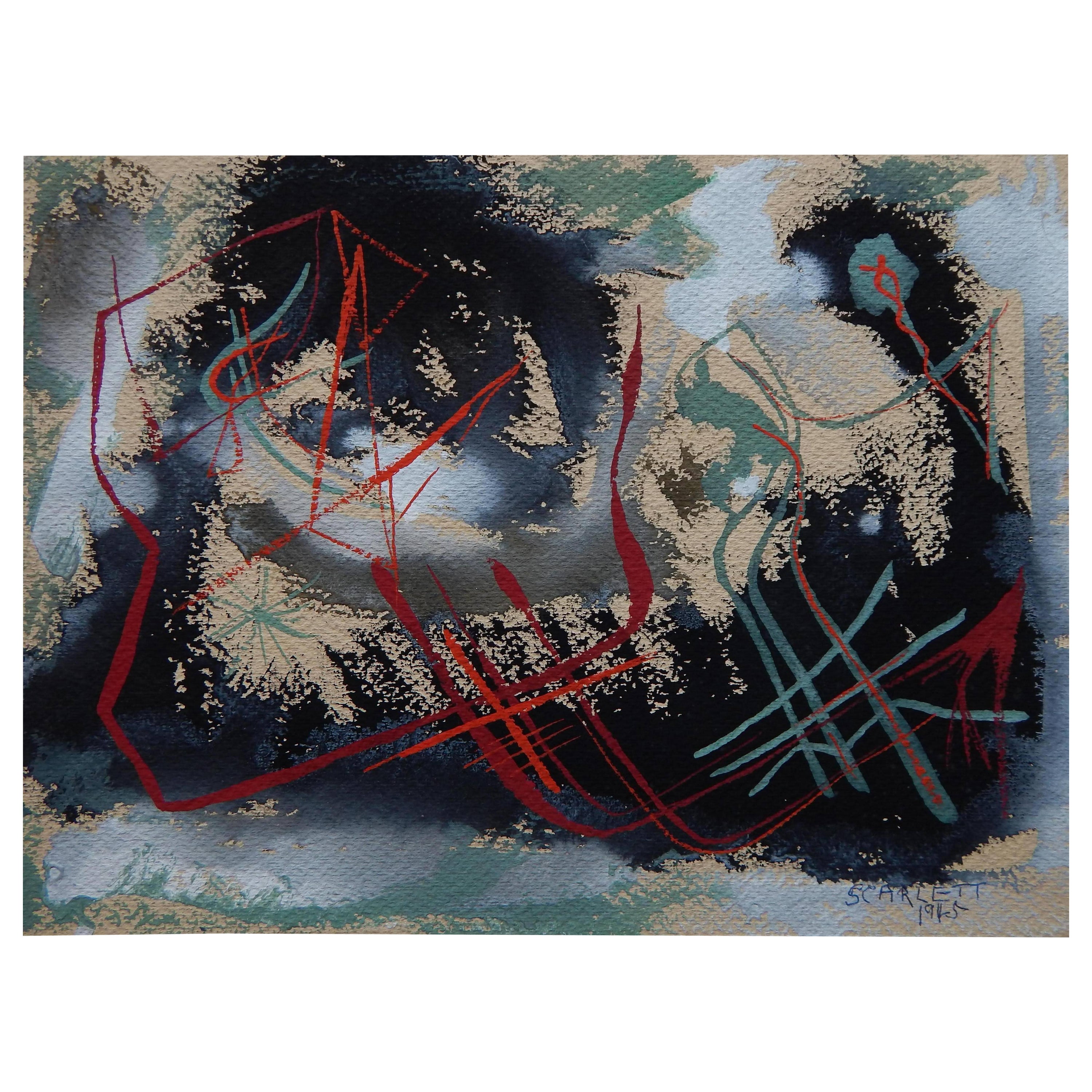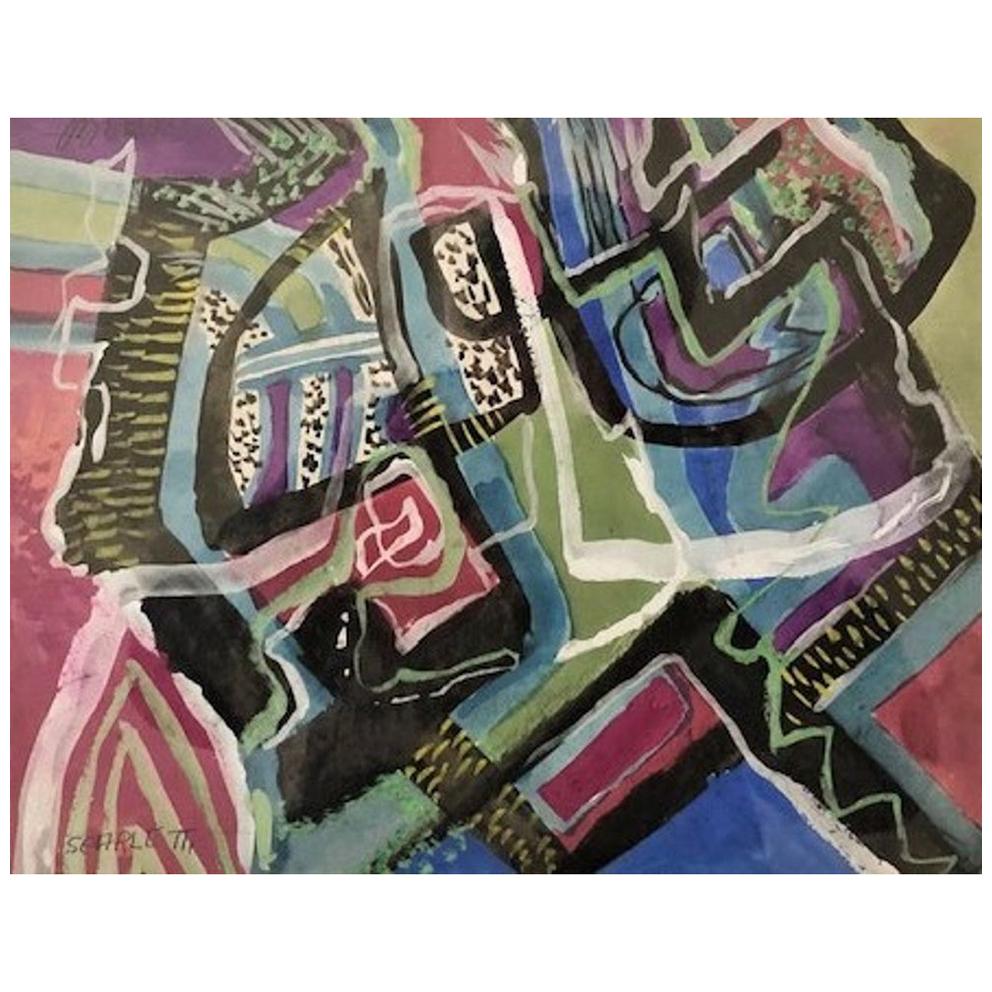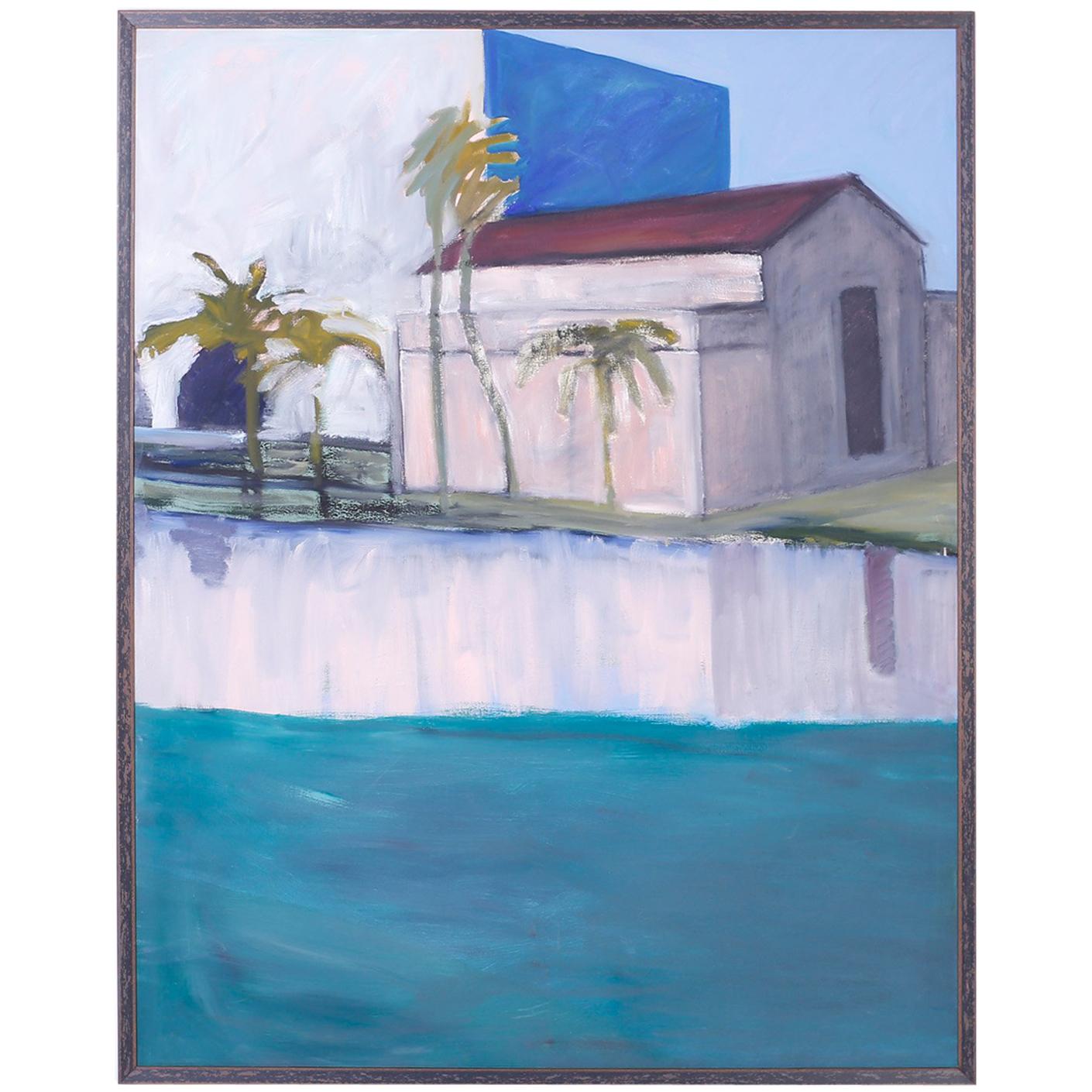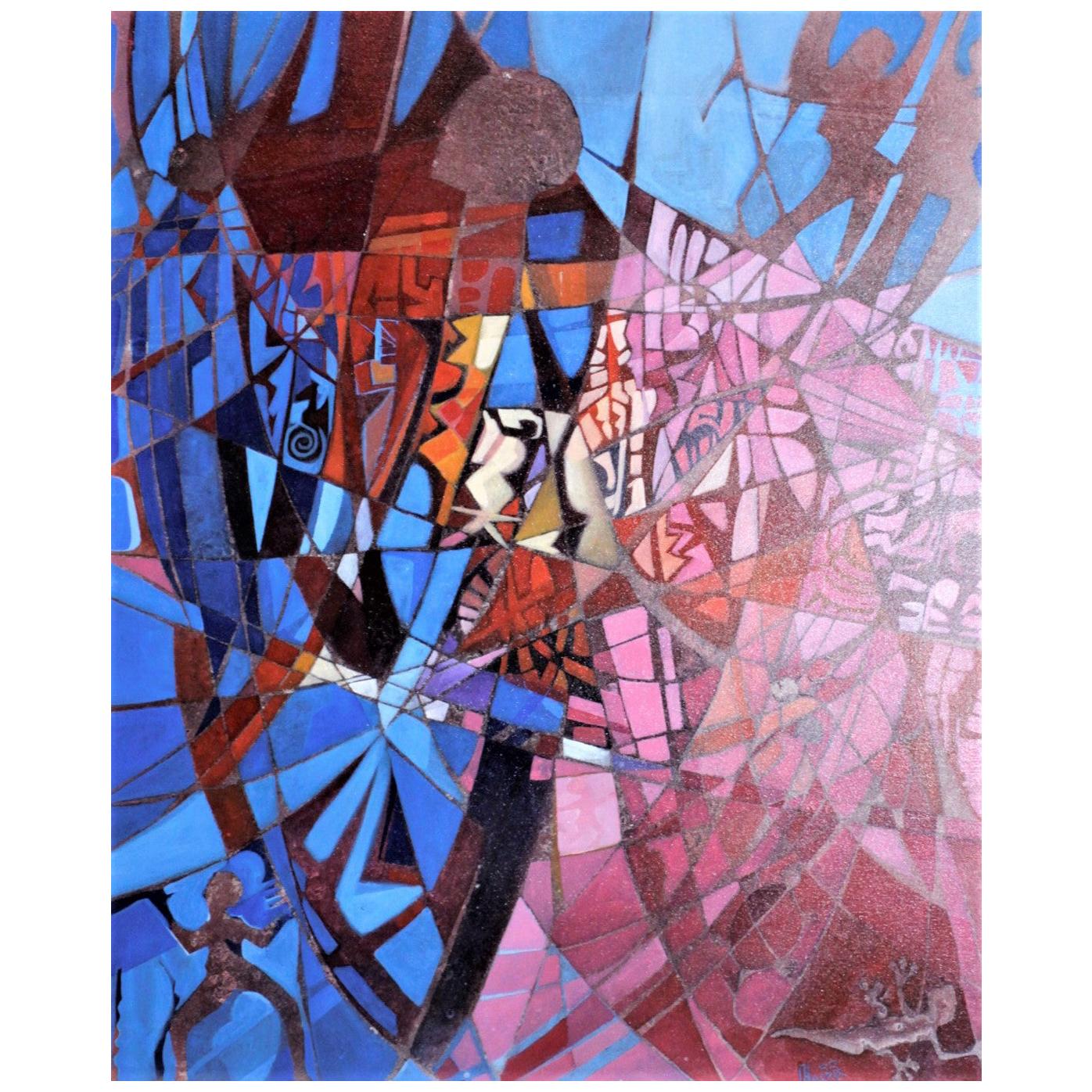Items Similar to Rolph Scarlett Original Non-Objective Modernist Oil Painting on Canvas: Untitled
Want more images or videos?
Request additional images or videos from the seller
1 of 14
Rolph Scarlett Original Non-Objective Modernist Oil Painting on Canvas: Untitled
About the Item
This original painting was done by the well known Canadian-American Rolph Scarlett, dating to approximately 1950 and done in his Non-Objective Modern style. This abstract painting is done with oil on canvas in his own original hand-crafted pine shadow box styled frame with a powder blue painted exterior and cream border. The painting is clearly signed in the bottom right corner and retains its original gallery label on the back. Rolph Scarlett has exhibited in many very prominent museums including the Metropolitan Museum of Art in New York and the Guggenheim Museum among others. Please note the posted dimensions refer to the framed artwork. The canvas itself measures approximately eighteen and a quarter inches wide and twenty one and three quarter inches in height.
- Creator:Rolph Scarlett (Artist)
- Dimensions:Height: 23.25 in (59.06 cm)Width: 19.25 in (48.9 cm)Depth: 1.75 in (4.45 cm)
- Style:Mid-Century Modern (Of the Period)
- Materials and Techniques:
- Place of Origin:
- Period:
- Date of Manufacture:1950
- Condition:Wear consistent with age and use. Minor losses. Some light wear to the sides of the frame, and some curling of the canvas as presented in the photos, and consistent with age and use.
- Seller Location:Hamilton, CA
- Reference Number:1stDibs: LU1355235551282
About the Seller
5.0
Platinum Seller
These expertly vetted sellers are 1stDibs' most experienced sellers and are rated highest by our customers.
Established in 2010
1stDibs seller since 2015
1,213 sales on 1stDibs
Typical response time: 1 hour
- ShippingRetrieving quote...Ships From: Hamilton, Canada
- Return PolicyA return for this item may be initiated within 3 days of delivery.
More From This SellerView All
- Original Carlisle Harris Modernist Abstract Acrylic Painting on Canvas UntitledLocated in Hamilton, OntarioThis large and well executed abstract painting was done by Carlisle Ainsworth Harris of Trinidad in 1990. This original painting is a framed acrylic on canvas and highlights Harris's...Category
Late 20th Century Unknown Modern Paintings
MaterialsCanvas
- Original Antique James Edwin Meadows Framed Oil Painting on Canvas UntitledBy James Edwin MeadowsLocated in Hamilton, OntarioThis antique original oil painting on canvas was done by James Edwin Meadows, a known British artist, in approximately 1860 in the period Victorian style. The painting depicts an Eng...Category
Antique Mid-19th Century English Victorian Paintings
MaterialsGesso, Canvas
- James Docharty Original Oil on Canvas 1874 Landscape PaintingBy James DochartyLocated in Hamilton, OntarioScottish artist James Docharty (1829-1878) 1874 oil on canvas painting with a beautiful ornate original gold frame. Actual picture size: 24 inches wide x 36.25 inches long x 1 inch d...Category
Antique 1870s Scottish Victorian Paintings
MaterialsPaint
- Original Manly E. MacDonald 'Canadian' Oil on Canvas Board Landscape PaintingLocated in Hamilton, OntarioThis original painting was done by the Canadian artist, Manly E. MacDonald in circa 1960 in his semi-impressionistic style. The painting is done on canvas artist's board and is a Can...Category
Mid-20th Century Canadian Other Paintings
MaterialsCanvas
- Antique Original John Munnoch Framed Oil on Canvas Landscape PaintingLocated in Hamilton, OntarioThis original antique oil on canvas painting was done by John Munnoch of England in approximately 1900 in the period late Victorian style. The painting is a well executed landscape o...Category
Early 20th Century English Late Victorian Paintings
MaterialsCanvas
- Rita Mount Painting, Oil on CanvasBy Rita MountLocated in Hamilton, OntarioRita Mount (1884-1967) - Canadian. "EFFET D’OMBRE A MIDI." A.R.C.A. Oil on canvas. Measures: 34.3" wide x 30.2" high without frame. 45" wide x 40" high with frame. Free shipping within the United States and Canada. A student of art from the age of 10, Rita Mount received extensive artistic training, studying at the Cercle Internationale des Beaux-Arts in Paris, the Art Association of Montreal under William Brymner (where she won a two-year scholarship), the Art Students’ League under Frank V. Du Mond, and taking courses in landscape painting with John Fabian Carlson in New York state. Following her studies, she returned to Canada and established a studio in Montreal. In search of new landscapes, Mount traveled all-over North America, driving to Banff in 1934, and to Victoria and Yellowstone Park, Wyoming in 1937. She then turned east, painting in Cape Breton Island, Nova Scotia, the Gaspe, and elsewhere in Quebec. Throughout her travels, she sketched and painted. Her work, combining impressionism and decorative realism, has been shown at the Continental Galleries, Watson Art Galleries, Klinkhoff Gallery, Morency Frères Ltee (all in Montreal), the New York World’s Fair (1939), the Coronation Exhibition, London, England, and the British Empire Overseas Exhibition. A member of the Independent Art Association, she also participated in exhibitions of the Ontario Society of Artists, the Art Association of Montreal and the Royal Canadian Academy, of which she was elected an associate in 1938. In addition, the artist mounted a three-woman show at the Municipal Building, St. Andrew’s East, near Montreal in 1958 with Irene Shaver and Vivian Walker...Category
Vintage 1930s Canadian Paintings
You May Also Like
- Rolph Scarlett Abstract Expressionist Painting, 1945By Rolph ScarlettLocated in Phoenix, AZAbstract expressionist gouache and watercolor on paper by noted artist Rolph Scarlett - Signed and dated lower right. Archivally matted, unframed. Image size: 11" H x 15" W. In excellent condition. Rolph Scarlett was a painter of geometric abstraction during the American avant-garde movement of the 1930s and 1940s. Born in Guelph, Ontario, Canada in 1889, he left Canada at the age of 18 to go to New York City and returned to Canada during the years of World War I. However, by 1924 he had established New York City as his home. While he was beginning his career as an abstract painter, he was designing stage scenery for George Bernard Shaw...Category
Vintage 1940s American Mid-Century Modern Paintings
MaterialsPaper
- Rolph Scarlett, Modernist Abstract Composition, Guache on Paper, Ca. 1950’sBy Rolph ScarlettLocated in New York, NYArtist: Rolph Scarletti (Canadian, 1889 – 1984) Object: Modernist Abstract Composition Period: Ca. 1950’s Medium: Guache on paper, framed Dimensions (unframed): Height: 9-1/3” Width: 12” Dimensions (framed): Height: 22-3/4”” Width: 25-3/4” Rolph Scarlett (Canadian, 1889 – 1984) was a consummate explorer of twentieth-century abstract painting. Never afraid of trying new styles, curious and opinionated, constantly engaged with the world around him while steadfastly aware that he was on his own path and his alone, Scarlett more than once proved to be at the artistic zeitgeist of the eras in which he lived. Exposed very early on to the work of Paul Klee through a chance meeting in Europe with the artist himself, Scarlett took up abstraction with a fervor that never diminished during his long and impressive career. To create something that had never existed before: this was Scarlett’s great cause. And that is what is most obvious when you look at Scarlett’s work—you have never seen anything quite like it. Scarlett was Canadian-born, came of age in the Midwest, and spent few important years in Hollywood, where he designed stage sets. His work from this early period echoes Klee’s use of color, his confidence in naïve, primitive forms, and his blend of abstraction and figuration. In its flat spatial qualities it prefigures the Indian Space painting of the 1940s by a decade. He moved to New York in 1933 and eventually found his first great patron at the Museum of Non-Objective Painting, directed by Baroness Hilla Rebay and art patron Solomon R. Guggenheim. Guggenheim would collect over 60 works by Scarlett for his collection, more than any other artist outside of Vasily Kandinsky and Rudolf Bauer. As a frequent exhibitor and lecturer at the Museum of Non-Objective Painting (MNOP), Scarlett honed his sensitive feel for bodies in space and capitalized on his trademark use of bright, vivacious colors into accomplished, perfectly harmonized geometric works. However, Scarlett soon morphed these hard-edged forms into a nuanced expressionistic abstraction which, at its best, seems to be populated by dancing forms that animate the canvases. Along this way he was advised by Rudolf Bauer, the German expatriate and one of the originators of non-objective painting in the teens. Bauer had the idea for the Museum, and Rebay, his champion, had found in Solomon Guggenheim a patron for manifesting it. When Bauer emigrated just before World War II, he wanted to meet Scarlett. The two became friends, and Bauer advised Scarlett on his work over the course of many years. Even in a 1979 interview, Scarlett began to tear up as he recalled his first meeting with Bauer, a man whose work he "worshipped," describing that, "It was a touching moment for me, I’ll tell you." Scarlett and Rebay also had a close, important relationship, one in which he bore the brunt of her sometimes condescending, if motherly, critiques and admonitions with tolerance and gratefulness. Eventually, though, he had to push back. In a letter from 1951 he writes, "I have noticed with growing amazement that during the past three years you have accepted less and less of my work—and, that same work, which you rejected has been accepted and shown in the best and largest shows all over this country." This period—the late 1940s to the early 1950s—did in fact correspond to Scarlett’s most critical success, and to a return to the fanciful forms and characters of his pre-war work. At the same time, he found his own rhythm and complexity using a drip style similar to, though denser and more opaque than, the one made famous by Jackson Pollock, who had worked for many years at the MNOP and with whom he shared common influences. In 1949 he had a very well received solo show in 1949 at the Jacques Seligmann Gallery, reviewed very favorably in The New York Times: "The impression made by these paintings is one of originality and strength." He was also included in a juried show "American Painting Today" at the Metropolitan Museum of Art in 1950 and in the Whitney Annual of 1951. The curator for the Whitney show in fact bypassed a selection of Scarlett’s careful geometrics in favor of a new "lyrical" drip painting—one which he describes as having had "a helluva good time" making. Rebay articulated her loss of control over Scarlett very keenly in one of her last official letters to him: "So your way ended in the horrid jungle it is in now; even a Mr. Pollock’s smearage was not bad enough for you to have a try at; and betraying yourself, you betrayed art and my faith in you, and my present disgrace by my failure to foresee such an outrageous possibility—since you even paint objectively now." Yet, despite the fact that he was moving in his own direction when the change in leadership took place at the Museum of Non-Objective Painting and Rebay was forced out as director, Scarlett was hit hard. He understood this change rightly as a betrayal by the establishment. Scarlett was a unique individual and soul, and was affected personally and philosophically by the idea that the movement with which Scarlett had aligned his talents seemed to disappear overnight, and his life’s work rendered valueless. Without the Museum’s support, Scarlett decided eventually to move to the artists’ community of Shady, New York, just outside of Woodstock. He had occasional shows throughout the years, but mostly settled down to regional obscurity. He began making jewelry, which had been his first trade, and it was following a show of his jewelry in 1975 at the Jaro Gallery, that he was rediscovered by Samuel Esses, and his wife Sandy. Samuel Esses was a successful businessman and an avid collector. He always sought out that which was unusual and, like Scarlett, was ahead of his time in many ways. For example, in 1979, Sam became enthralled with the early graffiti appearing on the New York subway trains. With the sole goal of preserving these groundbreaking yet short lived works of art he was inspired to create "The Esses Studio," a painting warehouse and workshop for graffiti artists to work in a studio, collaborate, and paint on canvas. The biggest names of graffiti writing participated—Futura, Crash, Dondi, Zephyr, and Daze to name a few. The project was well received and provided critical validation at an important time for this alternative form of abstraction to be recognized by the established art world. The success of the "Esses Studio" helped fuel an alternative fire that would propel gallerists and curators to acknowledge other street artists and provide a foundation of acceptance for the early careers of Keith Haring and Jean-Michel Basquiat. It is not a stretch to say that what Esses saw in the graffiti art of the 1970s was very similar to what he saw in 1950s-era Scarletts—something raw, honest, and melding many twentieth century influences into one unique form. Inspired by the importance of the collection and the passion of the collector, Weinstein Gallery...Category
Vintage 1950s Canadian Mid-Century Modern Paintings
MaterialsPaper
- Rolph Scarlett Original Watercolor Dated 1952, Geometric AbstractionBy Rolph ScarlettLocated in Phoenix, AZAbstract watercolor by Rolph Scarlett, signed lower left. A great example by Scarlett. Measures: 19" H x 21" W image size. New modernist custom-made frame. Size: 24 1/4" H x 26 3/4" W. Rolph Scarlett was a painter of geometric abstraction during the American avant-garde movement of the 1930s and 1940s. Born in Guelph, Ontario, Canada in 1889, he left Canada at the age of 18 to go to New York City and returned to Canada during the years of World War I. However, by 1924 he had established New York City as his home. While he was beginning his career as an abstract painter, he was designing stage scenery for George Bernard Shaw...Category
Mid-20th Century American Mid-Century Modern Paintings
MaterialsPaper
- Modernist Tropical Oil Painting on CanvasLocated in Palm Beach, FLMid-Century Modernist oil painting on canvas with a disciplined Minimalist style contrasting geometric forms with organic blowing palm trees and reflective pond.Category
Mid-20th Century American Mid-Century Modern Paintings
- Modernist Still Life Oil Painting on CanvasLocated in Palm Beach, FLMidcentury oil painting on canvas with an adept use of bold colors and a joyous spirit. The Classic still life genre re-invented over century is well represented here as a modernist ...Category
20th Century American Mid-Century Modern Paintings
MaterialsPaint
- Vintage French Modernist Signed Abstract Original Oil Painting on CanvasLocated in west palm beach, FLA fabulous vintage Boho original oil painting. A beautiful French abstract signed by the artist. Beautiful warm colors in this bold composition. Acquired from a Miami estate. The ...Category
Mid-20th Century French Paintings
MaterialsCanvas, Paint





